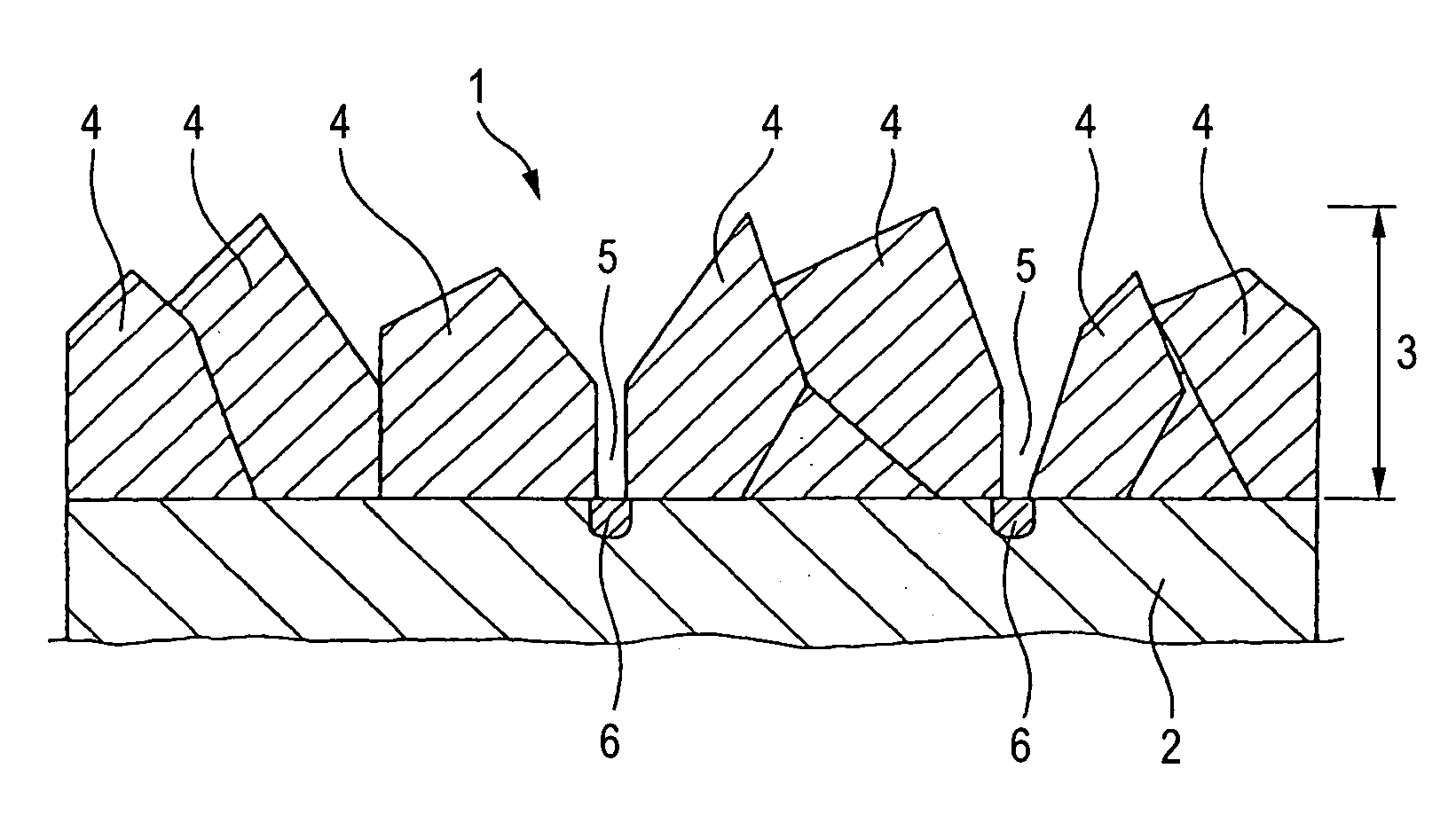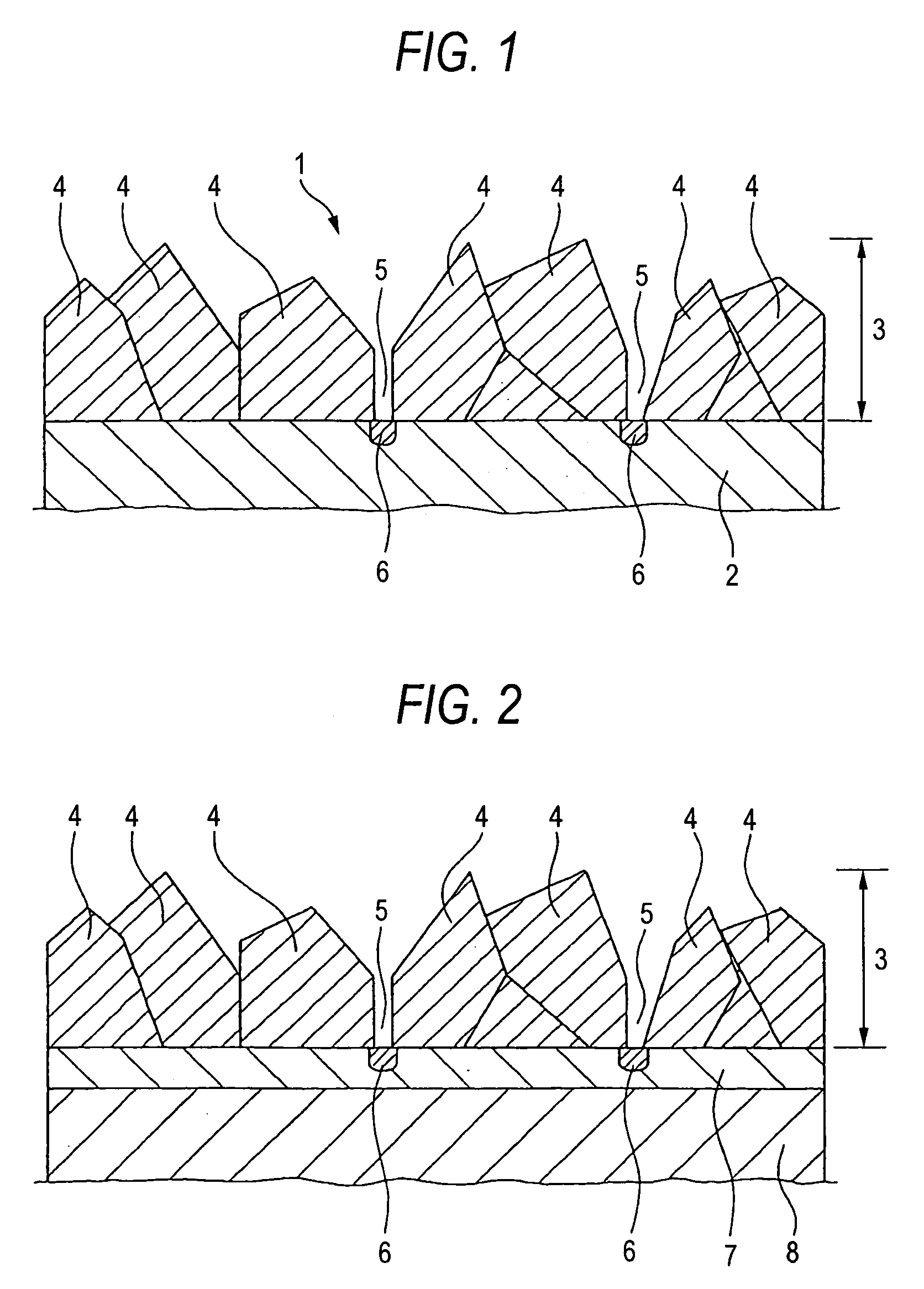Conductive diamond electrode and process for producing the same
a diamond electrode and diamond technology, applied in the direction of electrochemical machining apparatus, discharge tube/lamp details, solid state diffusion coating, etc., can solve the problems of insufficient life of the electrode, disturbed process spread, and insufficient objective reaction, so as to prevent corrosion of the exposed portion
- Summary
- Abstract
- Description
- Claims
- Application Information
AI Technical Summary
Benefits of technology
Problems solved by technology
Method used
Image
Examples
example 1
[0062] A graphite plate was used as a conductive substrate. A conductive diamond was synthesized on the surface of the conductive substrate using a hot filament CVD apparatus under the following conditions, thereby covering the surface.
[0063] The substrate surface was abraded with an abrasive comprising fine diamond particles (3 μm diameter). The surface was activated and nucleated. The substrate thus treated was mounted on a hot CVD apparatus. Ethyl alcohol was used as a carbon source. Boron carbide was dissolved in ethyl alcohol in a concentration of 5,000 ppm, and the resulting solution was incorporated into a carbon source vessel.
[0064] Hydrogen gas was flown through the apparatus at a rate of 0.15 liter / min. Part of the hydrogen gas was by-passed into the carbon source vessel to make an ethyl alcohol concentration to hydrogen be 1 vol %. Electric current was applied to the filament while flowing those gases through the CVD apparatus, to elevate the temperature to 2,400° C. at...
example 2
[0067] Electrolytic fluorination treatment of the conductive diamond-covered substrate produced in the same manner as in Example 1 was conducted under the following conditions. The substrate was mounted on the electrode jig, and was used as an anode in KF.2HF molten salt electrolytic bath having 100 ppm of pure water added thereto. A nickel plate was used as a cathode. Electrolytic fluorination treatment was conducted at a current density of 10 A / dm2 for 30 minutes to obtain a conductive diamond electrode. As a result of analyzing the conductive diamond after fluorination treatment with SEM observation, it was confirmed that the appearance of the diamond catalyst layer did not change before and after the fluorination treatment. Further, as a result of conducting electrolysis in the same manner as in Example 1, a stable cell voltage was maintained even after passing 1,000 hours, and corrosion of the substrate or peeling of the diamond catalyst layer was not observed.
example 3
[0068] A conductive substrate was prepared by covering a surface of a graphite substrate with a silicon carbide coating having a thickness of 25 μm by CVD method. Using the conductive substrate, conductive diamond was synthesized on the surface of the substrate to cover the surface thereof under the same conditions as in Example 1. The substrate was subjected to fluorination treatment in the same manner as in Example 1, except that the temperature inside the heating vessel was 300° C., to obtain a conductive diamond electrode. Using the conductive diamond electrode, electrolysis was conducted in the same manner as in Example 1. As a result, a stable cell voltage was maintained even after passing 1,000 hours, and corrosion of the substrate or peeling of the diamond catalyst layer was not observed.
PUM
| Property | Measurement | Unit |
|---|---|---|
| temperature | aaaaa | aaaaa |
| temperature | aaaaa | aaaaa |
| current density | aaaaa | aaaaa |
Abstract
Description
Claims
Application Information
 Login to View More
Login to View More - R&D
- Intellectual Property
- Life Sciences
- Materials
- Tech Scout
- Unparalleled Data Quality
- Higher Quality Content
- 60% Fewer Hallucinations
Browse by: Latest US Patents, China's latest patents, Technical Efficacy Thesaurus, Application Domain, Technology Topic, Popular Technical Reports.
© 2025 PatSnap. All rights reserved.Legal|Privacy policy|Modern Slavery Act Transparency Statement|Sitemap|About US| Contact US: help@patsnap.com


